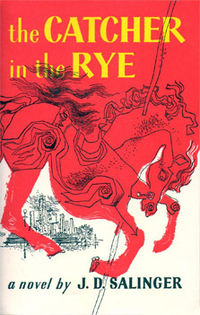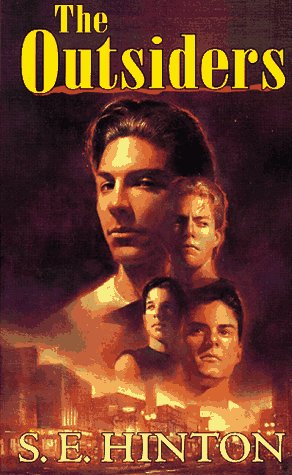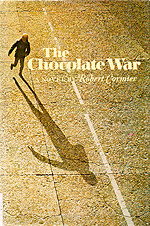What Does It Mean to Be a Young Adult
This article is from the annal of our partner ![]() .
.
Y.A. for Grownups is a weekly series in which we talk about Y.A. literature—from the now nostalgia-infused stories we devoured as kids to more gimmicky tomes being read past young people today.
When we launched our series on Young Developed fiction for the many adults who are reading those books, we didn't consider information technology a statement about the official publishing-world definition of "Y.A." That'southward why, in our start installation, we included a number of technically not-Immature-Developed books. Some, like From the Mixed Up Files of Mrs. Basil Eastward. Frankweiler or Beverly Cleary's Ramona serial, are what you'd call "middle form," or fifty-fifty "children's," for the under-12 prepare. Books like A Tree Grows in Brooklyn and Anne of Dark-green Gables came earlier the term "Y.A." came into wide utilize, and so, while they featured girl characters of a certain age, and go along to be read fondly by girls of various ages, they were technically books for grown-ups. Meanwhile, the subsequently books in the Harry Potter and Twilight series, for instance, skew on the older side of Y.A., with very adult situations unfolding for older characters—perhaps another reason they've constitute such a cross-over audience with adults.
For our purposes, information technology doesn't so much matter what the strict publishing definition of Y.A. is: this series is about re-reading the books we grew up on, and revisiting them in new means, as well as looking at new books that captivate not but kids only also adults. We cared less about what they were sold as, or what office of the library or bookstore nosotros found them in, every bit long equally they were books nosotros felt strongly nearly as adults, even if they were technically targeted to younger readers. It did matter to some of our readers, however, who pointed out—very nicely, we'd add—that we weren't quite being accurate with our terminology here:
Of course, these are valid points, and lead to interesting questions. What exactly is "Y.A."? What does it mean? Why did it brainstorm in the first place, and when was that? What has it become since? We conferred with librarians, agents, publishing globe executives, and the experts of the Internet to put together a primer of sorts. They don't all agree, either—nor is this current-twenty-four hours definition i that will remain and then forever. As writer Michael Cart, writing for YALSA, the Young Adult Library Services Association, for which he is a former president, explains, "The term 'young adult literature' is inherently amorphous, for its constituent terms 'immature adult' and 'literature' are dynamic, changing as civilisation and society — which provide their context — alter."
What is Y.A., exactly?
 Jim McCarthy, Vice President at Dystel & Goderich Literary Direction, is an agent whose authors include Richelle Mead of theVampire Academy series and Jessica Spotswood, writer ofBorn Wicked. He told The Atlantic Wire, "I don't know that there'south a real technical definition of what Y.A. is. Substantially, it's just literature for and nearly teens, in that location to bridge the gap between children's and developed's books. It can be subdivided into the aforementioned genres as adult books—romance, paranormal, mystery, horror, literary fiction." Rita Meade, a children's librarian in Brooklyn, explained, "I was 'officially' taught in grad school that Y.A. Lit is literature written with readers from ages 12 - eighteen in mind. I'm certain there's a marketing angle involved somewhere, just from my perspective every bit a children's librarian, information technology is helpful to make a distinction betwixt children'southward lit, Y.A. lit, and adult lit. That'southward non to say that at that place can't be crossover, or that one age grouping tin can't read books geared towards some other age grouping, merely information technology'southward useful when doing reader's reference to have a general guide. (Of course, there are many other factors that come into play when I advise books, but historic period level is normally the easiest place to start.)"
Jim McCarthy, Vice President at Dystel & Goderich Literary Direction, is an agent whose authors include Richelle Mead of theVampire Academy series and Jessica Spotswood, writer ofBorn Wicked. He told The Atlantic Wire, "I don't know that there'south a real technical definition of what Y.A. is. Substantially, it's just literature for and nearly teens, in that location to bridge the gap between children's and developed's books. It can be subdivided into the aforementioned genres as adult books—romance, paranormal, mystery, horror, literary fiction." Rita Meade, a children's librarian in Brooklyn, explained, "I was 'officially' taught in grad school that Y.A. Lit is literature written with readers from ages 12 - eighteen in mind. I'm certain there's a marketing angle involved somewhere, just from my perspective every bit a children's librarian, information technology is helpful to make a distinction betwixt children'southward lit, Y.A. lit, and adult lit. That'southward non to say that at that place can't be crossover, or that one age grouping tin can't read books geared towards some other age grouping, merely information technology'southward useful when doing reader's reference to have a general guide. (Of course, there are many other factors that come into play when I advise books, but historic period level is normally the easiest place to start.)"
1 thing Y.A. is not is a genre; it's a category, as with adult literature, containing all sorts of types of writing, from fiction to nonfiction. As Tracy van Straaten, VP at Scholastic, reminded us, "Something people tend to forget is that YA is a category not a genre, and within information technology is every possible genre: fantasy, sci-fi, contemporary, non-fiction. At that place'due south so much richness within the category."
What's the history of the category?
Cart writes,
When the term beginning constitute common usage in the belatedly 1960's, it referred to realistic fiction that was set in the real (equally opposed to imagined), contemporary world and addressed problems, issues, and life circumstances of interest to young readers aged approximately 12-18. Such titles were issued by the children's volume divisions of American publishers and were marketed to institutions – libraries and schools – that served such populations.
While some of this remains true today, much else has changed. In recent years, for case, the size of this population group has inverse dramatically. Between 1990 and 2000 the number of persons between 12 and 19 soared to 32 1000000, a growth rate of seventeen pct that significantly outpaced the growth of the rest of the population. The size of this population segment has also increased as the conventional definition of "immature adult" has expanded to include those as immature as ten and, since the belatedly 1990s, as old equally xx-v.
Leonard Marcus, historian, critic, and writer, told The Atlantic Wire that the history of "Y.A." goes all the way back to the psychologist G. Stanley Hall, who'due south credited with defining adolescence as a phase of life in the early 1900s, when reformers focused on kids at chance, particularly kids growing up in intense urban environments, and tried to improve their lot in life. In the 1930s Margaret A. Edwards, who became an administrator of young adult programs at Enoch Pratt Free Library in Baltimore, took a special interest in writing for teens, and did significant piece of work to farther the category. (A yearly accolade is given in her award.)
 "Fast frontward to Catcher in the Rye in 1950," says Marcus. "Salinger did not have teens in heed equally his audience, but that's who ended upward reading the book." (McCarthy agrees, "Certain classics would be categorized as Y.A. if they were published today.Catcher in the Rye comes to heed. [The category] exists, actually, to serve a market need and to be able to target a more specific reader who might not find these books if they were published into the wilds of the adult fiction earth.") Regardless of its nomenclature, the volume became an anthem for anyone who related to Holden Caulfield'due south anti-hero alienation, his conflict between material wealth and a spiritual deficit, the challenges he faced on moral and social planes—and many of those who related the strongest were teens. Teen fiction began to emerge in that atmosphere, written by the likes of Mary Stolz, John Tunis, and then Robert Cormier, "who grew up on Salinger." The Chocolate War, his tertiary volume, and one we've all heard of, had originally been presented as a book for adults, simply his agent put it forward as a teen book for ameliorate sales. "He became the dean of teen fiction writers," says Marcus, with people like Judy Blume, Southward.East. Hinton, and Paul Zindel following in his stead.
"Fast frontward to Catcher in the Rye in 1950," says Marcus. "Salinger did not have teens in heed equally his audience, but that's who ended upward reading the book." (McCarthy agrees, "Certain classics would be categorized as Y.A. if they were published today.Catcher in the Rye comes to heed. [The category] exists, actually, to serve a market need and to be able to target a more specific reader who might not find these books if they were published into the wilds of the adult fiction earth.") Regardless of its nomenclature, the volume became an anthem for anyone who related to Holden Caulfield'due south anti-hero alienation, his conflict between material wealth and a spiritual deficit, the challenges he faced on moral and social planes—and many of those who related the strongest were teens. Teen fiction began to emerge in that atmosphere, written by the likes of Mary Stolz, John Tunis, and then Robert Cormier, "who grew up on Salinger." The Chocolate War, his tertiary volume, and one we've all heard of, had originally been presented as a book for adults, simply his agent put it forward as a teen book for ameliorate sales. "He became the dean of teen fiction writers," says Marcus, with people like Judy Blume, Southward.East. Hinton, and Paul Zindel following in his stead.
Marcus points to Globe War II every bit some other impetus in the cosmos of Y.A. literature. Teens were put through the very grownup experience of war, and came dorsum as veterans old beyond their years, while their younger brothers "felt they'd missed the experience of a lifetime." This, says Marcus, had a huge bear upon on society, setting the stage for things similar rock-and-roll, and more grown-up literature for "kids." Merely there's as well clearly a marketing element at work here: The creation of Y.A. as a category makes "good concern sense," says Marcus. "All along since the beginning of the 20th century, specialized publishing departments were existence formed, with the underlying idea to create a parallel globe to the world of the institutional book buyers."
Is there a difference in terms of sales for Y.A. versus adult fiction authors? What about advances?
From the perspective of the agenting world, McCarthy says, "Authors can certainly make the same sorts of advances in young adult publishing that they would on the adult side. In fact, quite a few brand significantly more than their adult counterparts because in that location's been such a boom in the category over the by 10 years. Just past the number of midlist adult fiction authors making the shift to Y.A., you can tell that a lot of people really see it as the real place to make money at present." (Authors who've written Y.A. include Michael Chabon, Isabel Allende, Dale Peck, Julia Alvarez, T. C. Boyle, Joyce Carol Oates, Francine Prose, and others). Says McCarthy, "There is a sense that this category is the bright spot in an increasingly challenging publishing universe." Marcus related a funny story: Apparently, when Hemingway was writing, his editor at Scribner told him if he took out the curse words and didn't say "damn" all the fourth dimension, he could exist a Y.A. novelist. He didn't try, but Marjorie Kinnan Rawlings, author of The Yearling, got the same advice, and heeded it.
How has the popularity of Y.A. changed readers, making them less concerned with categories?
 McCarthy cites Harry Potter and Twilight as "the real game changers in the category. They became monstrous forces because they had rabid teen fan bases, but they also bridged over to adult readers in large ways. Because Y.A. isn't as subdivided on bookshelves, authors don't need to worry about blending elements of different genres. If someone writes a fantasy romance, they don't have to be concerned about whether they're filed nether fantasy or romance and whether the readers of the other genre will seek them out. There's not bad ability in that, and authors have an easier time of working outside of genre constraints this way." All the same, McCarthy notes that the category may be entering a saturation stage: "With these huge successes, so many people are trying to cash in and publish into the Y.A. market, and in that location's a very real adventure of over-saturation. Also many people are on the bandwagon, so there has to be at least some degree of self-correction coming."
McCarthy cites Harry Potter and Twilight as "the real game changers in the category. They became monstrous forces because they had rabid teen fan bases, but they also bridged over to adult readers in large ways. Because Y.A. isn't as subdivided on bookshelves, authors don't need to worry about blending elements of different genres. If someone writes a fantasy romance, they don't have to be concerned about whether they're filed nether fantasy or romance and whether the readers of the other genre will seek them out. There's not bad ability in that, and authors have an easier time of working outside of genre constraints this way." All the same, McCarthy notes that the category may be entering a saturation stage: "With these huge successes, so many people are trying to cash in and publish into the Y.A. market, and in that location's a very real adventure of over-saturation. Also many people are on the bandwagon, so there has to be at least some degree of self-correction coming."
 Meade says more adults reading Y.A. is a good thing: "I do accept to be honest and say that it bothers me when adults turn upwards their noses at Y.A. lit without even trying it—at that place are some really fabled Y.A. books out there that have wide appeal." Van Straaten agrees, "The 'cross-under' trend is great. Some of the all-time books being published are in the Y.A. department, just many people didn't know about them. The exciting affair with the cross-over miracle is that it'due south not then much virtually where in the bookstore the books get shelved. Information technology used to frustrate me that my friends would watch a teen movie, but a Y.A. volume seemed remedial to them. Happily, that's not the instance now." And Marcus says this isn't a question of whether it'south happening: It'southward already happened: "The market is so hot," he says. "Two years ago was the last time I went to the Bologna Book Off-white, and the Y.A. books were the talk of the off-white."
Meade says more adults reading Y.A. is a good thing: "I do accept to be honest and say that it bothers me when adults turn upwards their noses at Y.A. lit without even trying it—at that place are some really fabled Y.A. books out there that have wide appeal." Van Straaten agrees, "The 'cross-under' trend is great. Some of the all-time books being published are in the Y.A. department, just many people didn't know about them. The exciting affair with the cross-over miracle is that it'due south not then much virtually where in the bookstore the books get shelved. Information technology used to frustrate me that my friends would watch a teen movie, but a Y.A. volume seemed remedial to them. Happily, that's not the instance now." And Marcus says this isn't a question of whether it'south happening: It'southward already happened: "The market is so hot," he says. "Two years ago was the last time I went to the Bologna Book Off-white, and the Y.A. books were the talk of the off-white."
Cart supports that with numbers: "Equally a result of these newly expansive terms [the "definition of Y.A."], the numbers of books beingness published for this audience take similarly increased, perhaps by as much as 25 percent, based on the number of titles beingness reviewed by a leading journal," he writes. "Though once dismissed as a genre consisting of petty more than than problem novels and romances, young adult literature has, since the mid-1990's, come of age as literature – literature that welcomes artistic innovation, experimentation, and hazard-taking."
Literature, that is, that people of all ages want to read. If ane of the bully values of Y.A. is its ability to, as Cart writes, "offer readers an opportunity to see themselves reflected in its pages," there's no stopping its cornball thrall for adults who want to continue to do this, whether they're re-reading books from their youth, or trying completely new ones out in their 30s.
This article is from the archive of our partner The Wire.
Source: https://www.theatlantic.com/culture/archive/2012/04/what-does-young-adult-mean/329105/

0 Response to "What Does It Mean to Be a Young Adult"
Post a Comment